Lenovo Business Model Canvas 2024
Lenovo is a globally successful tech company selling everything from consumer laptops to enterprise data center equipment, with a strong market position, particularly in PCs. Here, in this Lenovo business model canvas, we will learn its customer segments, value proposition, revenue streams, channels, customer relationships, key activities, key resources, key partners, and cost structure.
Interesting fact!
Lenovo partnered with Disney in 2016 to be part of a $100 million advertising campaign featuring Star Wars movies.
Lenovo Competitors
HP | Dell | Apple | Acer | Asus | Microsoft | Samsung | Xiaomi | Huawei | LG
Customer Segments – Lenovo Business Model Canvas
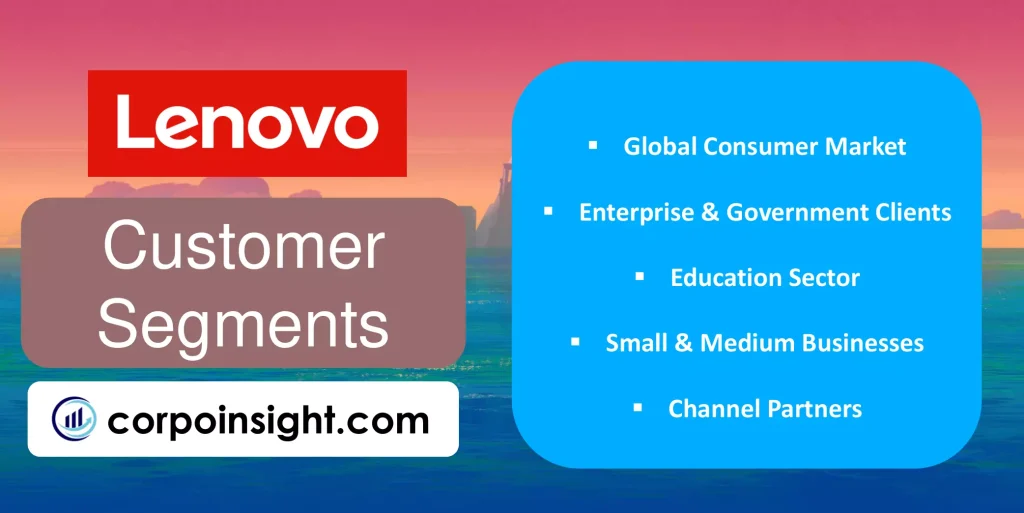
Global Consumer Market: As the #1 personal computer vendor globally, Lenovo targets mainstream individual shoppers across laptops, desktops, gaming PCs, workstations, AR/VR devices, and more. For example, IdeaPad laptops brought in approximately $3.23 billion in FY2022 consumer notebook sales.
Enterprise & Government Clients: Lenovo provides end-to-end technology solutions to large corporations and public sector organizations worldwide. In Q3 2022, Lenovo’s commercial PC and smart device group generated $2.45 billion for Lenovo.
Education Sector: Lenovo partners with many educational institutions to outfit classrooms and labs with student and teacher PCs, tablets, and accessories optimized for education. Lenovo claims over 30 million education users today.
Small & Medium Businesses: Lenovo develops specialized hardware, software, and services for SMBs without large enterprise IT resources. Around 40% of ThinkPad laptop purchases reportedly go to organizations with less than 1,000 employees.
Channel Partners: Lenovo sells solutions through global reseller partnerships with IT solution providers, systems integrators, service partners, retailers, telecoms, and other business partners who then supply solutions to end customers of all sizes and domains worldwide.
Value Proposition – Lenovo Business Model Canvas
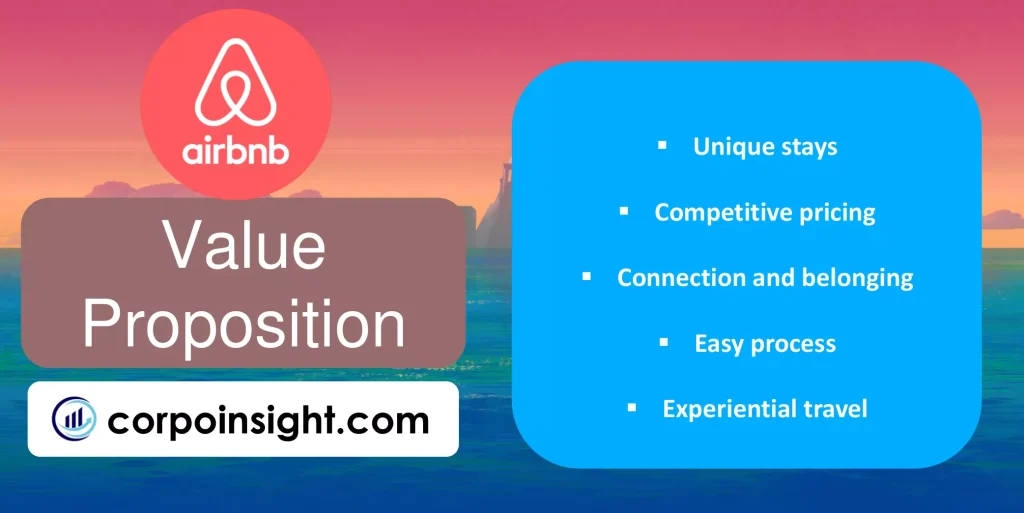
Product Breadth & Global Scale: As the #1 PC maker, Lenovo boasts expert global manufacturing and distribution covering 180+ markets. This allows economies of scale and local customization worldwide. For context, Lenovo ships over 70 million units annually from facilities in China, India, the USA, Mexico, and Hungary.
Vertical Solutions Focus: Lenovo designs specialized commercial solutions for manufacturing, retail, healthcare, and other verticals. For instance, ruggedized ThinkPad laptops serve public safety vehicle computing needs under extreme temperatures and conditions.
Innovative and Cutting-Edge Technology: Lenovo consistently invests in emerging tech across consumer and commercial devices. This includes pioneering work in AR/VR, foldable displays, 5G connectivity, AI-assisted software, and more. Lenovo’s 2021 R&D expenditure topped $1.5 billion alone.
Strong Enterprise Heritage and Reliability: From IBM’s storied Think brand to modern end-to-end data center infrastructure, Lenovo inherits and advances that enterprise focus for government, education, and Fortune 500 clients. Lenovo claims better than 99% server availability rates.
After-sales Services and Support: Lenovo provides technical support through 65+ call centers 24/7 worldwide, along with device warranties and protection plans, all aimed at maximizing uptime and productivity for business customers.
Revenue Streams – Lenovo Business Model Canvas

Product Sales: Lenovo generates the most revenue by selling laptops, desktops, tablets, smartphones, data center infrastructure, and related components. In FY2022, Lenovo recorded $71.6 billion in total consolidated revenue, up 18% year-over-year.
Services & Solutions: Lenovo also monetizes enterprise and SMB services around device lifecycle management, support, warranty upgrades, software customization, and vertical market solutions. Lenovo’s services-led Intelligent Devices Group logged over $6 billion in FY2022 sales.
Strategic Partnerships: Lenovo partners with other innovators to co-market joint solutions while sharing revenue. Recent examples include partnerships with Intel, SAP, AWS, Microsoft, Linux, and Red Hat around custom appliances.
Global Distribution Network: Lenovo sells directly online but also leverages a vast global distribution network of retail partners, carriers, value-added resellers, and IT solution providers, who each get a share of Lenovo device sales.
Brand Licensing & Ventures: Lenovo supplements hardware sales by licensing its trusted brand to third-party manufacturers in certain markets. It also co-invests in startups related to AI, cloud, 5G, edge, and other emerging segments.
Channels – Lenovo Business Model Canvas
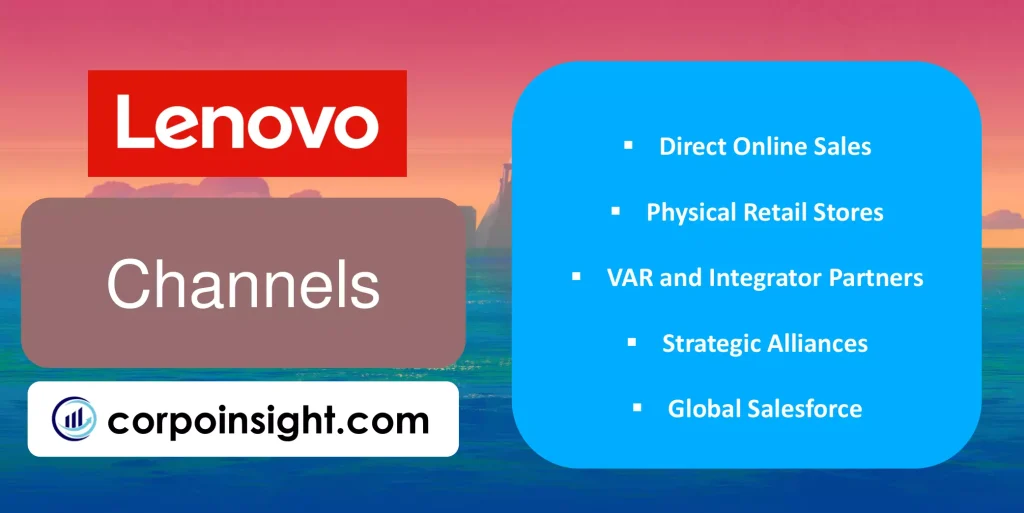
Direct Online Sales: Lenovo sells directly to consumers and businesses via lenovo.com sites in over 60 countries. This allows custom configurations and direct customer support. Q3 2022 direct online revenue grew 86% year-over-year.
Physical Retail Stores: Lenovo products are sold at thousands of retail locations globally through partnerships with electronics, IT, and cellular carrier stores like Best Buy, Walmart, Amazon, Telcel, Darty, MediaMarkt, and Flipkart.
VAR and Integrator Partners: Lenovo has a global network of over 28,000 value-added resellers and channel partners that package, customize, and deploy solutions for SMB and enterprise customers with specialized needs.
Strategic Alliances: Lenovo allies with other innovators like Microsoft, Linux, SAP, AWS, Intel, and Google to jointly develop and market solutions tailored for customer segments from education to manufacturing.
Global Salesforce: Lenovo utilizes a worldwide internal salesforce to manage enterprise and public sector accounts. For illustration, Lenovo has over 600 sales executives focused just on state, local government, and education sectors in the Americas region.
Customer Relationships – Lenovo Business Model Canvas
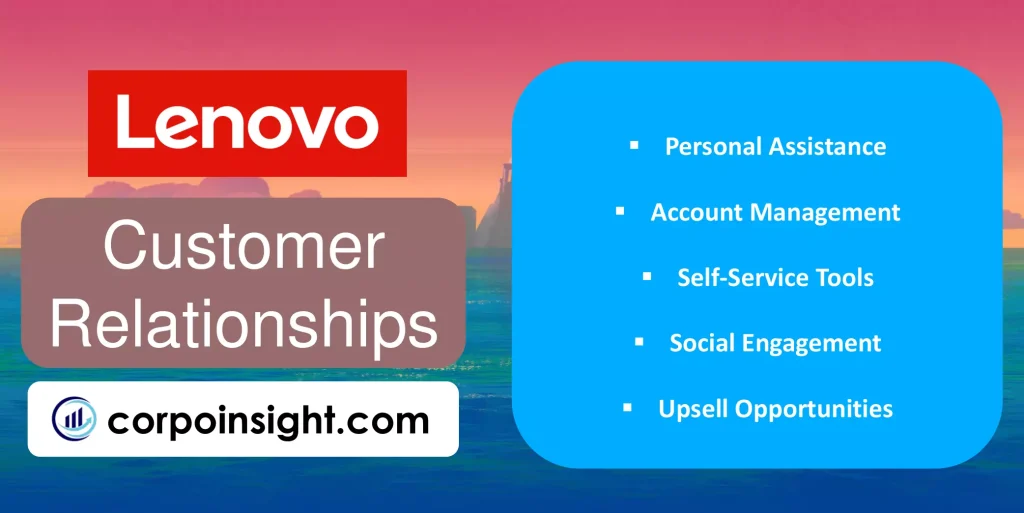
Personal Assistance: Lenovo provides direct customer support for consumers and businesses via phone, chat, email, social media, and forums in local languages. For example, Lenovo operates over 65 global call centers with 24/7 assistance.
Account Management: Lenovo assigns dedicated account managers to manage relationships and address the needs of large enterprise and public sector clients for a customized experience.
Self-Service Tools: Lenovo offers various self-help resources such as user forums, live chatbots, instructional videos, automated diagnostics, wiki-based troubleshooting guides, and hardware documentation to foster independence.
Social Engagement: Lenovo leverages various social media platforms like Facebook, Twitter, and WeChat to foster user communities for direct real-time support, sharing best practices, and two-way brand engagement in local markets.
Upsell Opportunities: Lenovo looks to build loyalty via special member deals, extended warranty programs, and competitive upgrade promotions on new devices that incentivize continued business for individual and enterprise buyers.
Key Activities – Lenovo Business Model Canvas
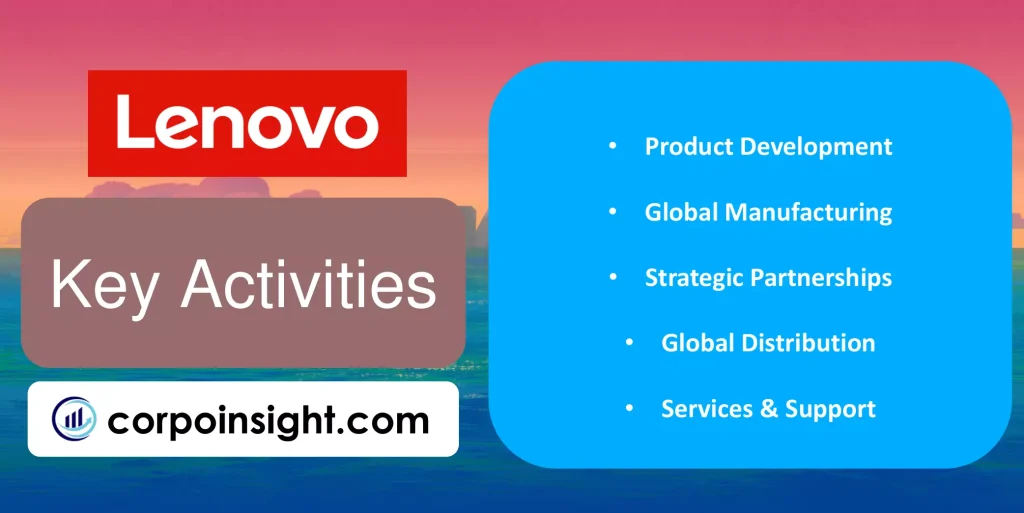
Product Development: Lenovo invests heavily in R&D to rapidly innovate and launch cutting-edge PCs, mobile devices, data center infrastructure, augmented reality solutions, and smart IoT across consumer and commercial segments. Lenovo spent $1.5 billion on R&D in FY2021.
Global Manufacturing: Leveraging a global supply chain and worldwide manufacturing footprint, Lenovo efficiently assembles millions of configured devices annually across facilities located in China, India, USA, Mexico, and Hungary, catering to regional customer demands.
Strategic Partnerships: Lenovo partners deeply with chipmakers like Intel and Qualcomm, independent software vendors like SAP and Adobe, channel distributors, and telecom carriers to co-innovate solutions tailored for target industry sectors and specialized use cases.
Global Distribution: Lenovo ships products to consumers in over 180 markets by coordinating a vast worldwide logistics network, supply agreements with retailers and carriers, and enterprise sales representatives in 60+ countries.
Services & Support: From 24/7 call centers to on-site technicians for commercial accounts, Lenovo provides integrated services and localized support globally to ensure continued client productivity and issue resolution when needed after the sale.
Key Resources – Lenovo Business Model Canvas
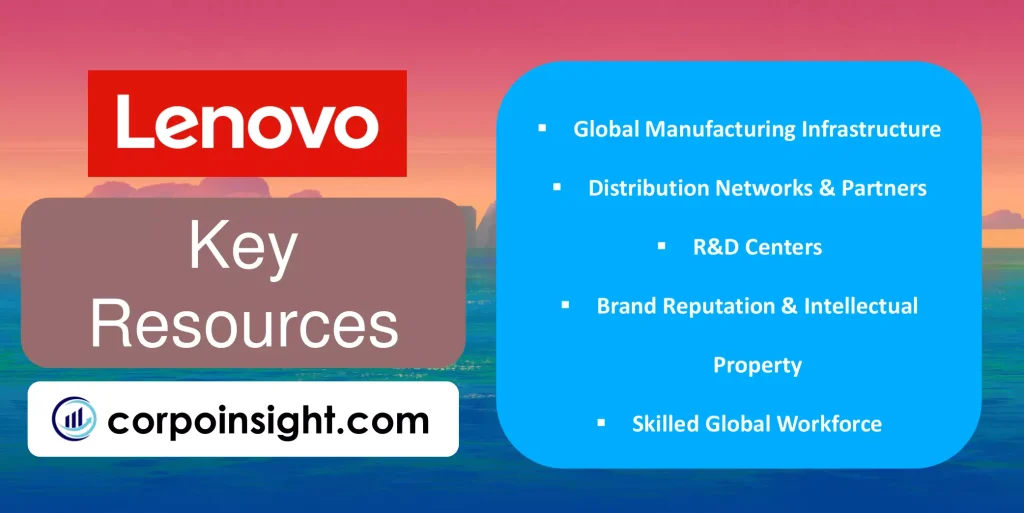
Global Manufacturing Infrastructure: Lenovo operates state-of-the-art manufacturing plants in China, India, USA, Mexico, and Hungary to produce integrated circuits, components, desktops, laptops, servers, and mobile devices at a massive scale for global markets.
Distribution Networks & Partners: Backed by a supply footprint in over 60 countries, Lenovo distributes products through key retail partnerships with Best Buy, Walmart, Amazon, Flipkart, and 28,000 value-added reseller partners, along with telecom tie-ups worldwide.
R&D Centers: With 50+ R&D labs located in China, Japan, and the USA, plus dedicated ZUK innovation labs, Lenovo develops breakthrough consumer and commercial devices, often launching 3000+ patents annually as of 2022.
Brand Reputation & Intellectual Property: Acquired IBM/Motorola brands like ThinkPad, along with unique IP in laptop convertible design, augmented reality, IoT, and secure supply chain, giving Lenovo an edge in existing and emerging solution areas worldwide.
Skilled Global Workforce: Lenovo retains operational excellence thanks to an efficient global workforce of around 63,000 employees representing diversity in backgrounds, cultures, and skillsets, as well as 10,000+ software engineers specifically focused on user-centric designs.
Key Partners – Lenovo Business Model Canvas
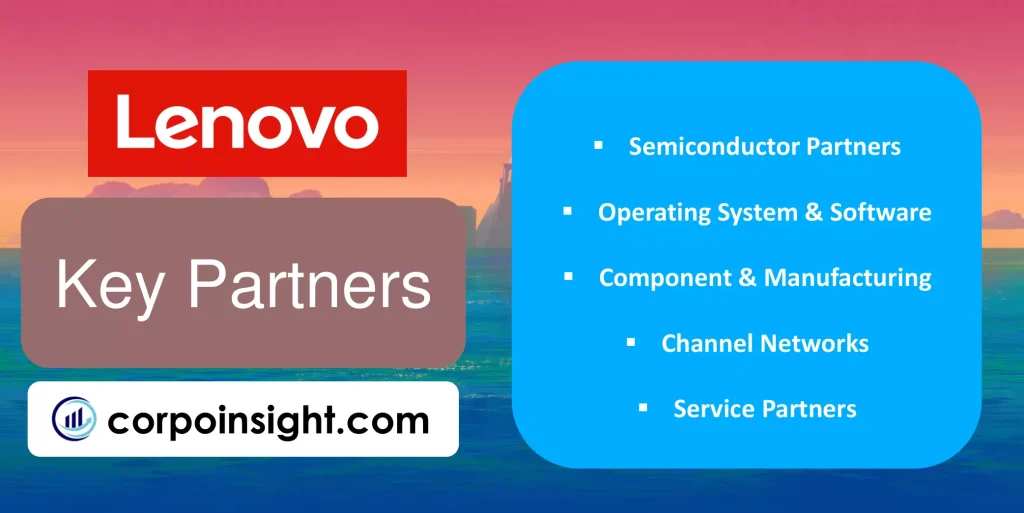
Semiconductor Partners: Lenovo works closely with leading chipmakers like Intel, AMD, and Qualcomm to optimize proprietary hardware and co-develop next-generation platforms for consumer and commercial devices with enhanced performance, connectivity, and battery life.
Operating System & Software: Strategic alliances with Microsoft, Linux, Android, and other ISVs like SAP drive tighter OS integration, security features, productivity capabilities, and optimized experiences across Lenovo end-user solutions tailored for market segments.
Component & Manufacturing: JVs, acquisitions, and supply partnerships across APAC deepen Lenovo’s capabilities in proprietary manufacturing while securing access to displays, memory, storage, and specialized components central to end product quality, pricing, and speed to market globally.
Channel Networks: Lenovo relies heavily on retail partnerships, value-added resellers, carriers, and system integrators comprising over 28,000 channel entities to package solutions and serve SMBs plus enterprises in local jurisdictions across 180+ markets worldwide.
Service Partners: Third-party partnerships supplement Lenovo’s capabilities in infrastructure support, device deployment, staff augmentation, specialized IT project consulting, and other technical areas to serve enterprise accounts and public sector clients better globally.
Cost Structure – Lenovo Business Model Canvas
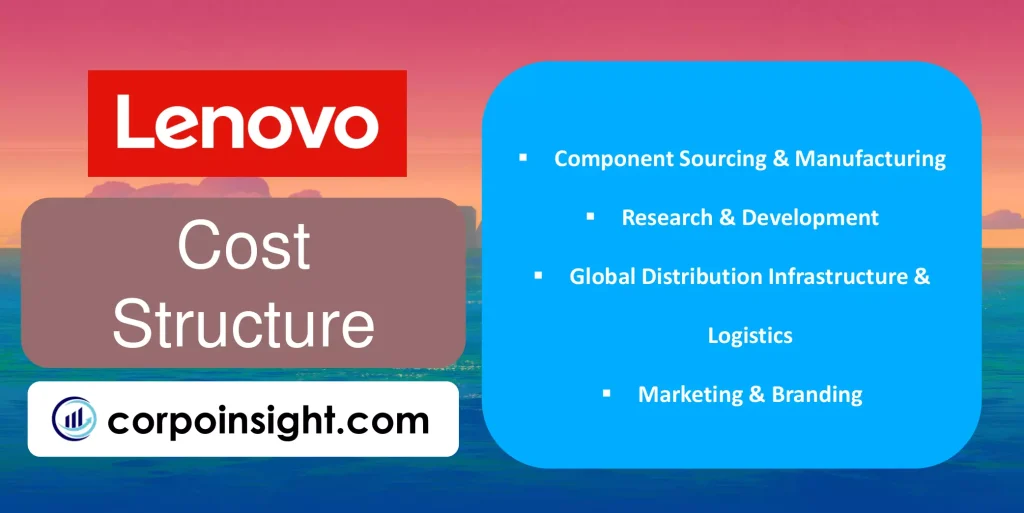
Component Sourcing & Manufacturing: Lenovo incurs major costs in the procurement of commodity components like chips, memory, and displays from partners, along with large investments in automated, high-volume manufacturing centered in Asia but expanding into Hungary, Mexico, and the USA.
Research & Development: With 50+ dedicated R&D labs and ongoing experiments in next-gen laptop, mobile, AR/VR, and data center designs, Lenovo sustains around 4% of yearly revenue in innovation investments to stay competitive long-term in consumer and enterprise solutions. In 2021, Lenovo spent $1.5 billion on R&D alone.
Global Distribution Infrastructure & Logistics: Given sales across 180+ markets, Lenovo maintains distribution centers worldwide along with localized sales support capabilities and incurs steady costs around shipping, delivery, and inventory management as products move through supply chains to reach consumers plus enterprise/SMB clients.
Marketing & Branding: Lenovo continues to make selective investments in advertising, strategic partnerships, and branding/sponsorships like the recent NBA partnership in order to drive premium positioning for flagship brands like ThinkPad and Legion gaming PCs in competitive global markets.
Summary of Lenovo Business Model Canvas
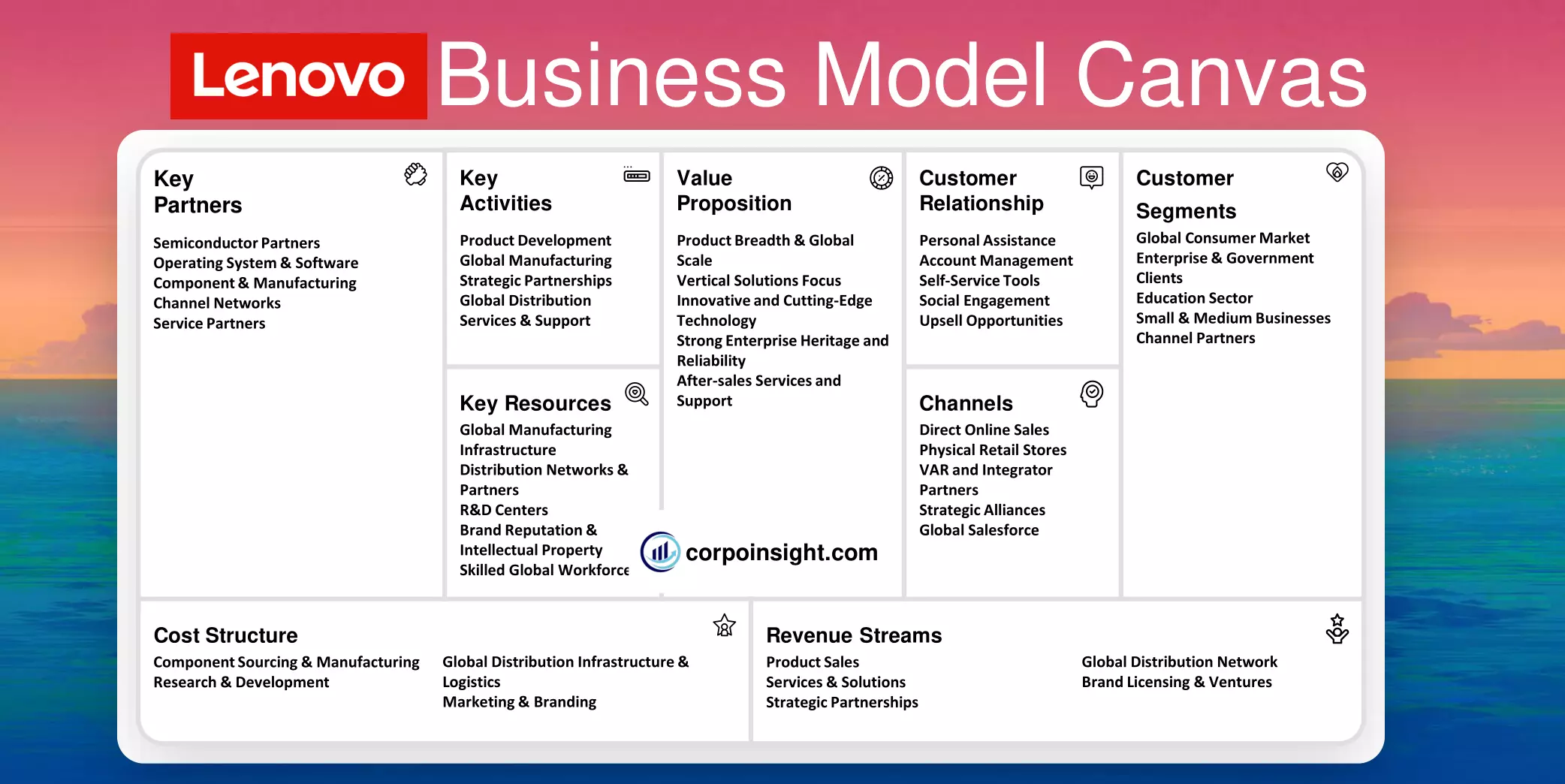
Conclusion on Lenovo Business Model Canvas
Lenovo sustains its position as the #1 global PC maker and emerging end-to-end technology provider by leveraging worldwide manufacturing and R&D, strategic software partnerships, a solutions-centric focus on commercial segments, a global distribution footprint and channel ecosystem, localized sales and service support, along with acquired brands and IP that set Lenovo apart in everything from consumer devices to data center infrastructure.

This is Ahsanul Haque, someone very passionate about digital marketing, SEO, and Data Analytics and founder of the Analytics Empire and currently pursuing my major in marketing at Bangladesh University of Professionals.





